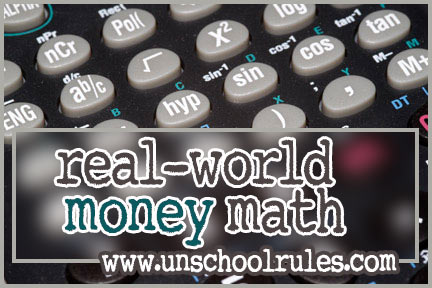I’ve got a bachelor’s degree in advanced math, and a 12-year-old daughter who hates anything to do with the subject.
I’m an unschooling mama who loves to do math puzzles and logic problems for fun.
I’m not sure if that combination makes me an expert or just crazy, but because of it, I agreed to take part in the iHomeschool Network’s “5 days of…” series this week with a look at 5 days of real-world math.
Today, we’ll look at three types of math you need to manage your money.
Inverse operations: That’s how you balance the checkbook
What, you don’t balance your checkbook? OK, first you have to go read about why I do in this post. Then come back here.
OK, you’re back? Here’s the thing. ASSUMING you keep track of your expenditures, it only takes basic addition and subtraction to see how much money you actually have. But to find out if you have missed transactions, you have to balance what you show against what the bank shows.
The REALLY simple version of this involves inverse operations. First, you’ll need to go through your bank statement or online record and make a note of which transactions you and the bank BOTH show. If they’ve got something you don’t (and it’s a valid charge), note that in your record. Then, you’re just left with the balance you have, the balance the bank has, plus a list of transactions that you show that haven’t cleared the bank yet.
To find out if you and the bank “match up,” you need to practice inverse operations. That just means you change the symbol. So if you show a balance of $500, but you have a check for $100 (a “negative”) that the bank doesn’t show yet, you need to ADD $100 to your balance, giving you $600 in “bank terms.” If that’s what they show – that’s perfect, because it means when your check clears the bank, you’ll have exactly the same amount.
Similarly, if you show a deposit that the bank hasn’t registered yet (a “positive”), you’ll need to SUBTRACT that amount to see if you balance.
It’s funny, but this is really hard for a lot of people to get – and, I think, a big reason why people don’t balance their checkbook as adults.
Where to start: First of all, I highly recommend having your children manage their own savings accounts, no matter their age. For the most part, this is simply a good place to put some birthday money, allowance (if you use it), loose change, etc., and have it start to earn interest, which your kids can track via statement.
As they get a bit older, withdrawing money for major purchases is a great lesson. My daughter has made two “major purchases” since opening her account four years ago – a bike and helmet, and a Nintendo 3DS video-game system.
She’s learned how to deduct her spending, and how to weigh the decision of how much to spend. Those are good starting points. As she gets older, we will help her manage her first checking account when she gets her first job. Some people fear this idea; I would rather her start this process WITH our guidance than without it when she’s 18!
If you personally don’t balance your checkbook, give it a shot – and let your kids see you doing so.
I’m a big fan of being open about money and how to manage it with children. How else are they going to learn? (Plus, you’ll be surprised at how much differently they act toward things when they see that your wallet is not an eternal fount of money!)
Dealing with credit and interest
This is another area in which your openness with your kids will be rewarded. No matter how you feel personally about credit cards – if you’re 100% OK with them or 100% against them – make sure your children know how interest and loaned money work.
I will never forget my nephew buying something pricey during college, then telling his parents, “Oh, I didn’t have to pay for that, I used a credit card.”
If you borrow money, it must be repaid eventually, and generally with interest. The longer you take to repay what you owe, usually the more interest you will pay on top of the original amount.
Do your children understand how the “business” of money works – and how they can either gain or lose money as part of it? Have you talked with them about what a bank does with your money – and how you can sometimes earn money by “loaning” yours to the bank temporarily?
Where to start: Again, be open. If you have an interest-bearing account of any kind, sit down with your kids and show them how you earned 10 cents or $1.18 or $450 this month simply by allowing that particular bank to use the money.
Interest isn’t too complicated when it’s earned simply, but the issue of credit is probably the most complicated part of this series, and the only part that I find hard to explain to really young children. That doesn’t mean you shouldn’t try!
One great thing to try with kids of any age is playing verbal “what if” games. “What if someone offered to give you $1,000 now, that you could pay back by giving them $10 a month for 100 months? Would you take it?”
Then add factors in. “What if you had to pay them for an extra year after that 100 months?” “What if you had to pay them for an extra year, but they gave you a really cool T-shirt?” “What if you had to pay them back $100 a month instead?”
For older kids, mix up what the money’s for. “What if you wanted the money for a car? What if you couldn’t get a job without the car?” If they don’t want the loan, have them brainstorm alternatives.
You don’t need to get into the “math” behind those decisions, but you need to start the thought process. There isn’t even a “right” or “wrong” answer in those scenarios, but you can add in ones that you think would sway your child one way or the other to see how he or she will respond!
Cost per use: When the thing that’s cheapest isn’t cheapest
I own a $300 purse, and it was one of the most economical purchases I’ve ever made.
No, I’m not a total spendthrift. I understand cost per use.
I use this purse every day. If I can use it for one year, my cost is less than $1 per day – about 82 cents. If I can use it for two years, that goes down to 41 cents per use. I fully expect it to go at least three years, which puts me about 20 cents per use, and beyond that I get down to about 10 cents!
I used to buy $30 to $50 purses, which would usually last me about three to four months before they’d get holes, or broken straps, or big stains. (I’m hard on purses.) Even at BEST, with four months of daily use, my cost per use on those is no lower than 25 cents, and usually closer to 42 cents. Then add in my time shopping for a new one, and suddenly I’m worse off than if I had gotten something “nice” in the first place.
Does it sound silly to break a purchase down like this? Probably. But it’s a great thought process, and one you can adapt to almost any purchase your family makes.
There are times when getting the least costly item AT THE TIME makes sense. When I need shower-curtain rings, I just want the set that’s going to cost me $1.50, not the $10 ones. No matter which set I get, I’ll use it for about the same length of time, so why not save some cash?
But there are other times when spending more is a savings in the long run. Another good example of this is in shoes. I can wear a $75 pair of shoes with great support for three months, and only visit my chiropractor once, for a $25 copay, a total cost of $100.
Or, I can have achy feet in a $25 pair of shoes and visit the chiropractor three times. Same total cost of $100, but a much more miserable Joan.
Where to start: Figure out the cost per use of something “expensive” in your house – maybe a video-game system or your computer. Have fun with it – let your kids estimate how many days a week it’s used, and how long you’ve had it, and how long you think you will continue to use it.
Then, figure out the same info for “cheap” stuff, like their sneakers. You may find that a laptop is “cheaper” than those Nikes!
Obviously, that’s comparing apples to oranges, but it’s a very real way to bring home what is actually a fairly difficult concept involving investment over time, depreciation and quality, and its uses are incredibly far-reaching. We make these considerations about almost every product we bring into our home. That’s math worth knowing.
The rest of the series
Sunday: When numbers matter: A look at math in the real world (introduction)
Monday: The math you need at the grocery store
Tuesday: The math you need in your kitchen
Today: The math you need to manage your money
Thursday: The math you need to play sports and do other fun stuff (yes, really!)
Friday: Real-world math resources you’ll love
More five-day fun
This post is part of the iHomeschool Network’s summer “Five Days Of…” series. Click the collage below to see how some of my fellow bloggers are spending their “five days,” and to learn more about our series sponsor, the BEECH Retreat bloggers’ conference!




You might also like...